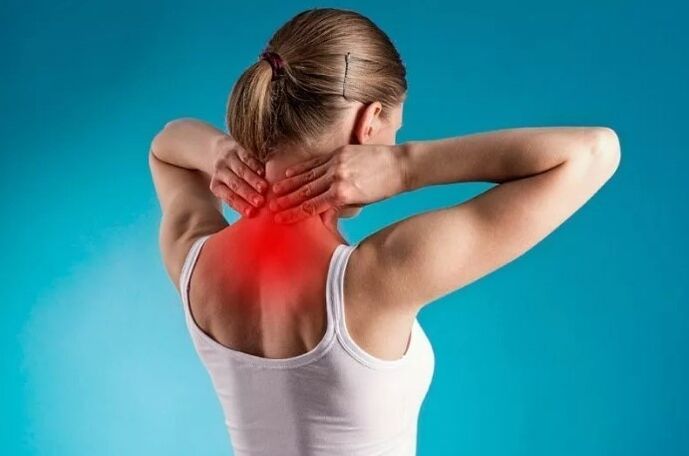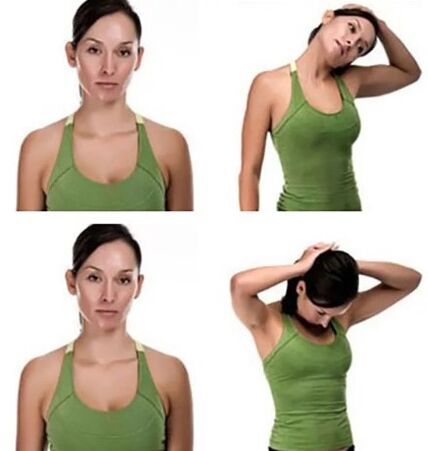Cervical osteochondrosis is a progressive dystrophy and deglycoside lesions of the intervertebral discs in the 1-7 vertebrae region of the cervical region.
Due to cervical osteochondrosis, deformation, exhaustion, and damage to the vertebrae body occurs. This destroys the normal blood supply and nerve conductivity in those areas innervated by the neck and cervical nerve roots.
Cervical osteochondrosis can be isolated or combined with osteochondrosis in other departments - waist and s bones.
reason

The causes of disease and degenerative changes in the intervertebral disc have not been fully studied. Osteocartilage degeneration is a hypothesis of confirmation. It can be found even among children and teenagers.
Many factors that distinguish between the development of osteochondrosis. These include:
- Sedomer and the sedentary lifestyle,
- The type of work sitting, there is a static load around the neck,
- Overweight, inadequate,
- The dysplasia of connective tissue,
- Violating blood circulation on the neck,
- Neck injury,
- Scoliosis, posture defects, uncomfortable pillows and mattresses,
- Genetic tendency, metabolic defect.
Symptoms of cervical osteochondrosis
The cervical vertebrae is particularly susceptible to the development of osteochondrosis-vertebrae, which is the smallest part of the spine, due to its skeleton characteristics, directness, and due to its large head size, the cervical vertebrae is particularly susceptible to the development of osteochondrosis compared to other parts of the spine, and the muscle frame is not very obvious.
The most characteristic symptom of complaints from patients - pain in the cervical area. Depending on the area of injury, the pain may be located
- on collar and shoulders;
- The entire cervical vertebra;
- On the front surface of the chest.
Pain in cervical osteochondrosis is due to characteristics of the cervical area.
The first sign of cervical osteochondrosis is insignificant and slightly specific:
- Neck pain at night
- The feeling of heavy head, headache of the occipital bone,
- The numbness or tingling feeling in the shoulders and hands,
- When turning the head, the crystals on the neck and click on the vertebrae.

Main symptoms:
Plant-based dynamic
- The pain in the neck, especially in the area behind the head, is quite severe;
- Pain occurs after staying in one position for a long time (such as after sleep);
- The neck muscles are constantly tensing.
- It's difficult to keep your hands aside.
- On the affected side, the fingers are restricted during movement.
As the vertebral artery is compressed, neurological manifestations are observed: headache, nausea, fainting.
Spine symptoms
The pain is located behind the left sternum.
This type of pain should be distinguished from the pain in angina (with angina, nitroglycerin relieves, osteochondrosis - NO).
Due to the gradual violation of the structure of the intervertebral discs, their compression (compression) occurs, and erosion of the nerve roots, as well as stenosis or erosion of arteries and veins that occur in the vertebral area.
This leads to the formation of special syndromes - root and ischemic.
- The root failure of the first cervical spine (C1): Violations can affect the back of the head, thereby reducing skin sensitivity;
- Lesion C2 is painful in the crown and the back of the head.
- C3 lesions cause neck pain from the infringing side, reduce sensitivity to the tongue and sublingual muscles, and in some cases, speech disorders and loss of control over language;
- Failure of C4 and C5 can reduce shoulder and clavicle pain, lower tone of head and neck muscles, heart beats, respiratory diseases and heart pain.
- Failed C6 is usually from the neck to shoulders, forearms, thumbs, and skin sensitivity may be affected:
- The failed C7 showed similar symptoms, pain in the back of the neck, shoulders, and until the back of the hand was in violation of the strength of the hand and the reflectivity was reduced.
Blood circulation diseases caused by migraines, severe dizziness, visual impairment and ears, flies flashing in front of the eyes, and autonomous dysfunction.

Heart syndrome may have symptoms of compressive heartache, lack of air and heartbeat, and rhythmic disease.
complication
Serious complications of cervical osteochondrosis are
- Herniation of the intervertebral disc, forming a hernia (protrusion);
- The rupture of the intervertebral disc is eroded by nerves and blood vessels, and compression of the spinal cord is possible, which may lead to death.
- Rhizoblastosis (lesions at the roots) may also be present, with bone plant formation (spikes on the vertebrae) showing relief and paralysis.
diagnosis
In the case of the above complaint, it is necessary to appeal to the orthopedic physician or neurologist.
First, the doctor will evaluate the activity and soreness of the neck, sensitivity and other functions. Then, if necessary, X-rays of the cervical spine are required to perform a calculated tomography or magnetic resonance scan and a hernia is suspected.
If you have a circulatory disorder, you need to have rheumatism and fundus examinations.
Treatment of cervical bone and chondropathy
Today, there are traditional and non-traditional methods for the treatment of cervical osteochondrosis.
Conservative methods mainly use:
- Symptomed treatment of pain medication can relieve pain syndrome
- Receive non-steraidal series of anti-inflammatory drugs to reduce inflammation and edema in tissues
- To eliminate muscle cramps, lumps were used, drugs to improve blood circulation.

In the treatment of cervical osteocartilage, substances that restore the structure of the intervertebral disc-cartilage protector are used.
The process of group B vitamin treatment is shown, and external products used for treatment are suitable - gels and ointments, creams with anti-inflammatory and analgesic ingredients. Shows irritants of disc regeneration.
Beyond and general massage, acupuncture, physics, physical therapy and gymnastics and gymnastics help in treating bone cartilage. The osteotherapy approach has proven itself well - a mild effect on the "clipping" bands of muscles and vertebrae.
In the treatment of cervical bone cartilage, a special collar (Shantsa collar) is recommended.
Complications of cervical bone cartilage and hernia can be quickly treated.
The duration of treatment depends on neglect of the condition, as osteochondrosis is a progressive chronic disease. Treatment can be long and lifelong prevention courses are conducted.
Proper nutrition will help relieve the condition of osteochondrosis.
Exercises for treating cervical osteochondrosis:
- Self-ejaculation: In the backrest position, the shoulders must be kept as low as possible, and the neck must be pulled up. The method must be performed at least 3 times a day 10 times.
- Self-Size: Use a towel to forgive your neck, take the towel to the end, then pull it for them, then pull it apart to spread the muscles of your neck. In this case, it is necessary to make sure the towel does not slide along the neck.
- Cervical regional gymnastics showing osteochondrosis: small bends of the neck and turns and tilts of the head. At one time, perform 5-7 tilts in each direction. This exercise is most useful for self-scaling of the cervical spine.
prevention
The basis of cervical health is a strong and healthy back, physical exercise, comfortable bed with anatomical pillow and mattress, proper posture and proper nutrition.
It's worth avoiding neck injuries and weightlifting. It is necessary to combine extended sitting postures with periods of rest and warmth.























